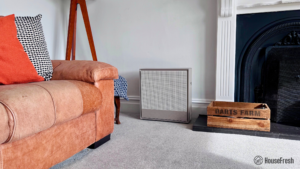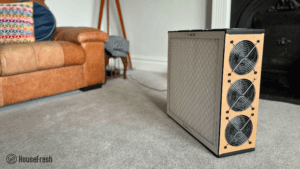Richard Taylor’s wife, Joyce, suffered from respiratory distress syndrome. He noticed that she only had relief when in a clean hospital room. So in 1990, he designed an air purifier that used True Medical HEPA and activated carbon to clean the air inside his home. Within a week of using the first device, Joyce could sleep undisturbed for the first time in years. That was the start of Austin Air.
Now, it’s one of the world’s largest air cleaning manufacturers, with a reported revenue of $19.2 million. What makes this brand stand out is that Austin Air purifiers use much more activated carbon than what is typically found in traditional consumer air purifiers, with around 15 lbs of carbon and zeolite in the HealthMate I am reviewing today.
While this means that Austin Air purifiers are among the highest-priced on the market, they are great at removing gases, odors and VOCs that standard air purifiers find much harder to remove. Austin Air was tested by the U.S. Army and fulfilled the largest deployment of air purifiers in American history to support the air quality concerns in post-9/11 NYC.
As with every air purifier review we publish here at HouseFresh, we bought the Austin Air HealthMate Standard (B400B1) with our own money to remain unbiased. We also run the same battery of tests we perform on every device we review to test air cleaning performance, noise levels generated, electricity consumption, long term user experience and yearly running costs.
TL;DR The lowdown on the Austin Air HealthMate

However, with its 15 lbs of carbon and a price that surpasses $700, this device is overkill for those looking to keep dust and pollen levels low due to its high initial and running costs.”
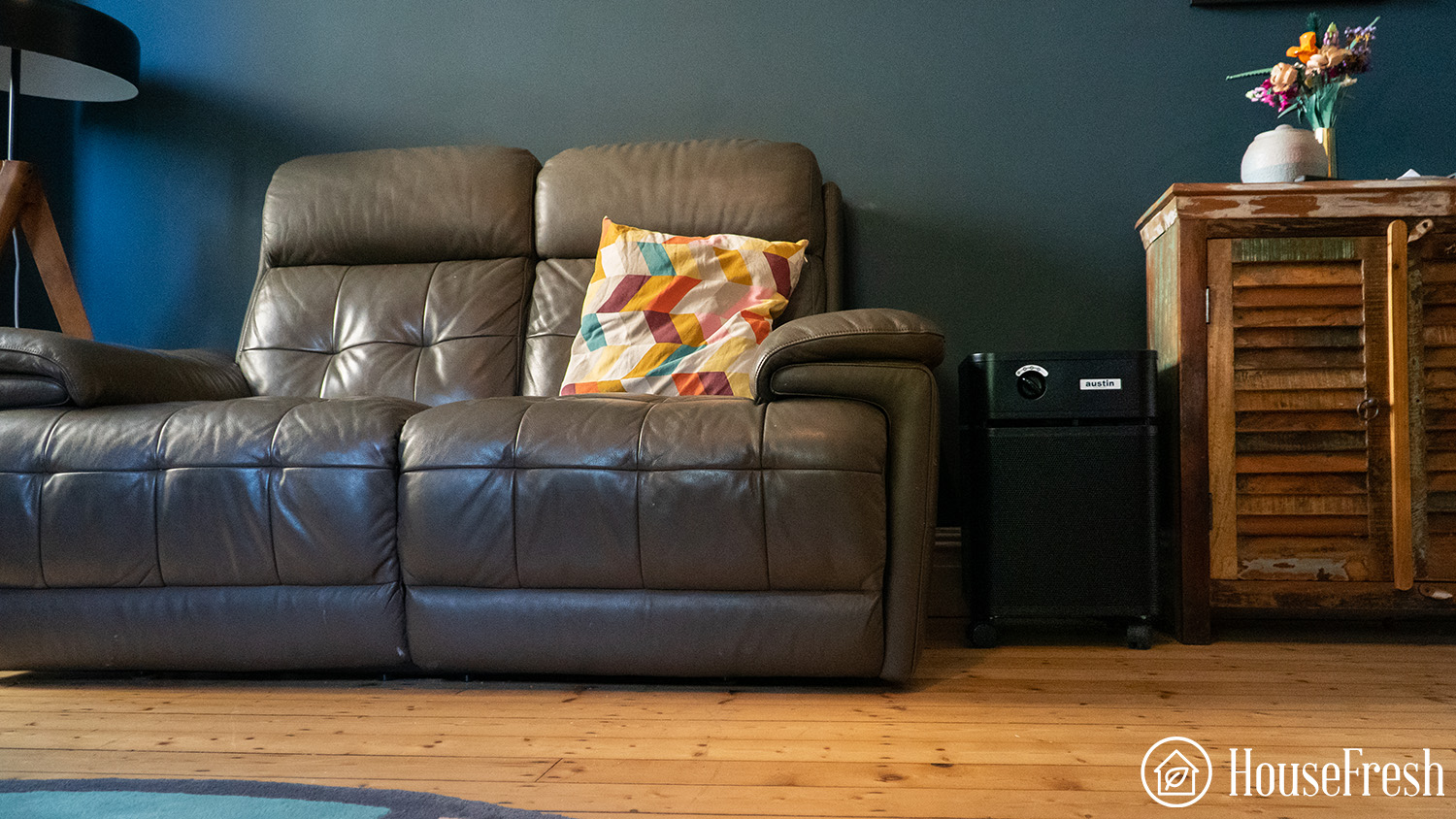
What we really like
What we think could be better
| HouseFresh rating: | ★★★★☆ |
| Time to clean our 728 cubic feet test room (with the device running at top speed): | 52 minutes |
| Air purifier technology: | HEPA filter and 15 lb of activated carbon |
| Recommended room size (estimated by HouseFresh to achieve 5 air changes per hour): | 234 sq. ft. |
| Clean air delivery rate (CADR): | Estimated: 156 CFM |
| Dimensions (in inches / in cm): | 23H x 14.5W x 14.5D inches (58.4H x 36.8W x 36.8D cm) |
| Weight (in pounds / in kg): | 20.41 lbs (9.26 kg) |
| Filter life: | 5 years |
| Noise level in decibels (measured from 3 ft. away with a sound level meter): | Speed 1: 42.5 dB Speed 2: 53.2 dB Speed 3: 61.5 dB |
| Electricity consumption in watts (recorded with an electricity usage monitor): | Standby mode: 0 watts Speed 1: 61.1 watts Speed 2: 85.05 watts Speed 3: 147.6 watts |
| Estimated running cost (electricity consumption + official filter replacement): | $283.03 per year |
| Cost per CADR cfm (based on dust CFM as reported by AHAM): | $4.80 |
| Manufacturer’s warranty: | 5 years |
| Country of manufacture: | U.S. (Buffalo, New York) |
The best feature: a large amount of activated carbon and zeolite
The Austin Air HealthMate comes with a HEPA filter and a whooping 15 lbs of carbon and zeolite.
This is the largest amount of carbon we have encountered in a filter across the nearly 100 air purifiers we have tested.
However, at over $700, this air purifier will be out of budget for most people. That is why I particularly want to highlight it for those of you wanting to remove harmful VOCs and unwanted odors from your air, as that is the one use case where spending $700 will make the most sense.
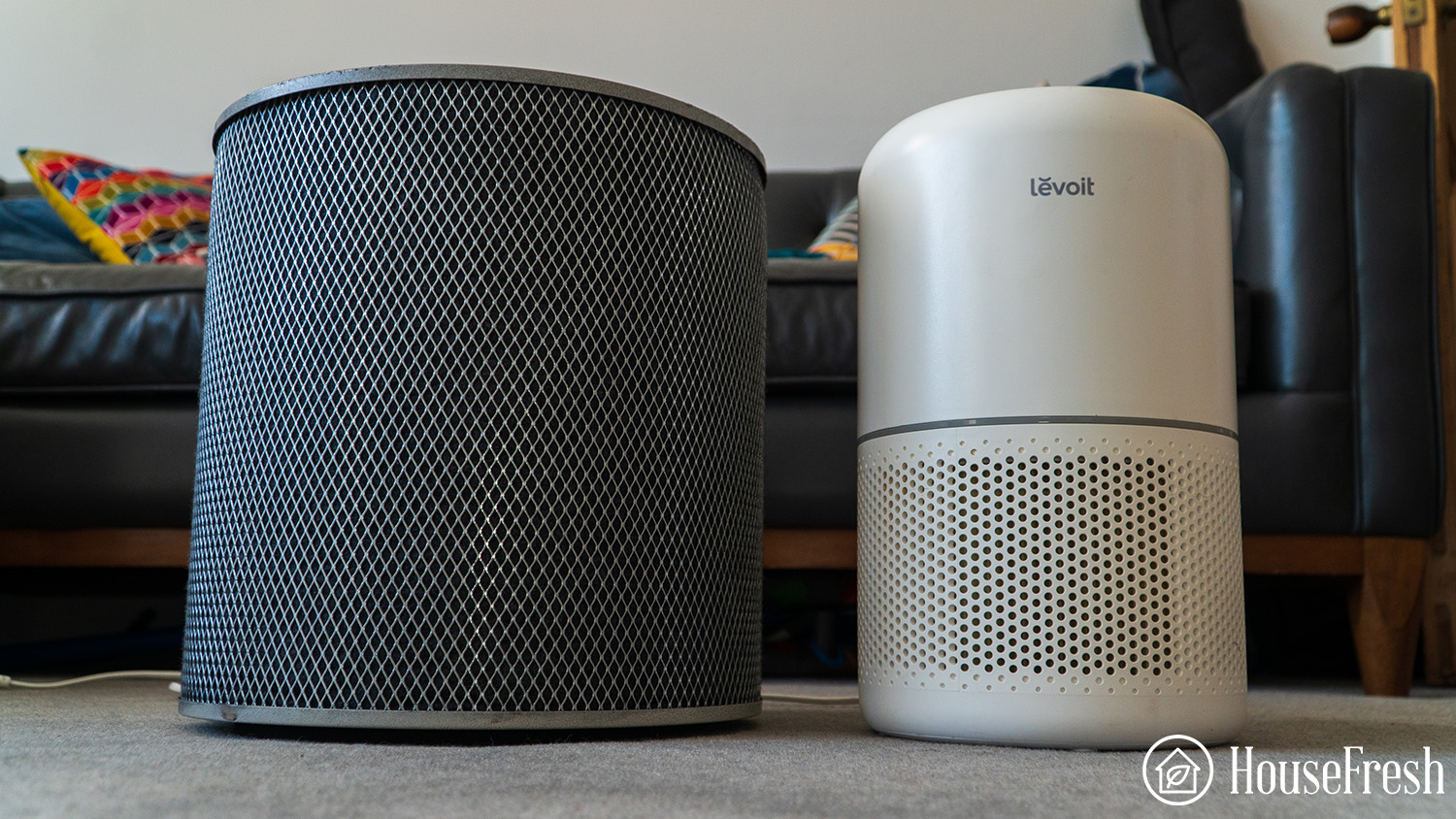
The closest I can make would be the IQAir HealthPro Plus, which costs around $900 and also comes with powerful HEPA filtration and a gas filter that combines activated carbon and zeolite, too.
The one thing I will say about the HealthPro Plus is that it performed better in our particle removal test, cleaning the air of PM1 pollutants in 28 minutes compared to the 52 minutes it took for the Austin Air HealthMate to achieve the same result.
Now, the big difference between the two is that the HealthPro Plus comes with only 5 lbs of carbon compared to the 15 lbs of carbon you get with the HealthMate.
Basic but stylish design with a straightforward control panel
Functional design elements that do the job without any bells and whistles.

I like the basic look of this air purifier. It’s a curved rectangular unit that fits nicely in a modern room.
I could feel the weight of the activated carbon filters as soon as this unit arrived. At 47 lbs (21.3 kg), you might need someone to help when you receive it, but once you have got it out of the box, the included wheels help move it around.
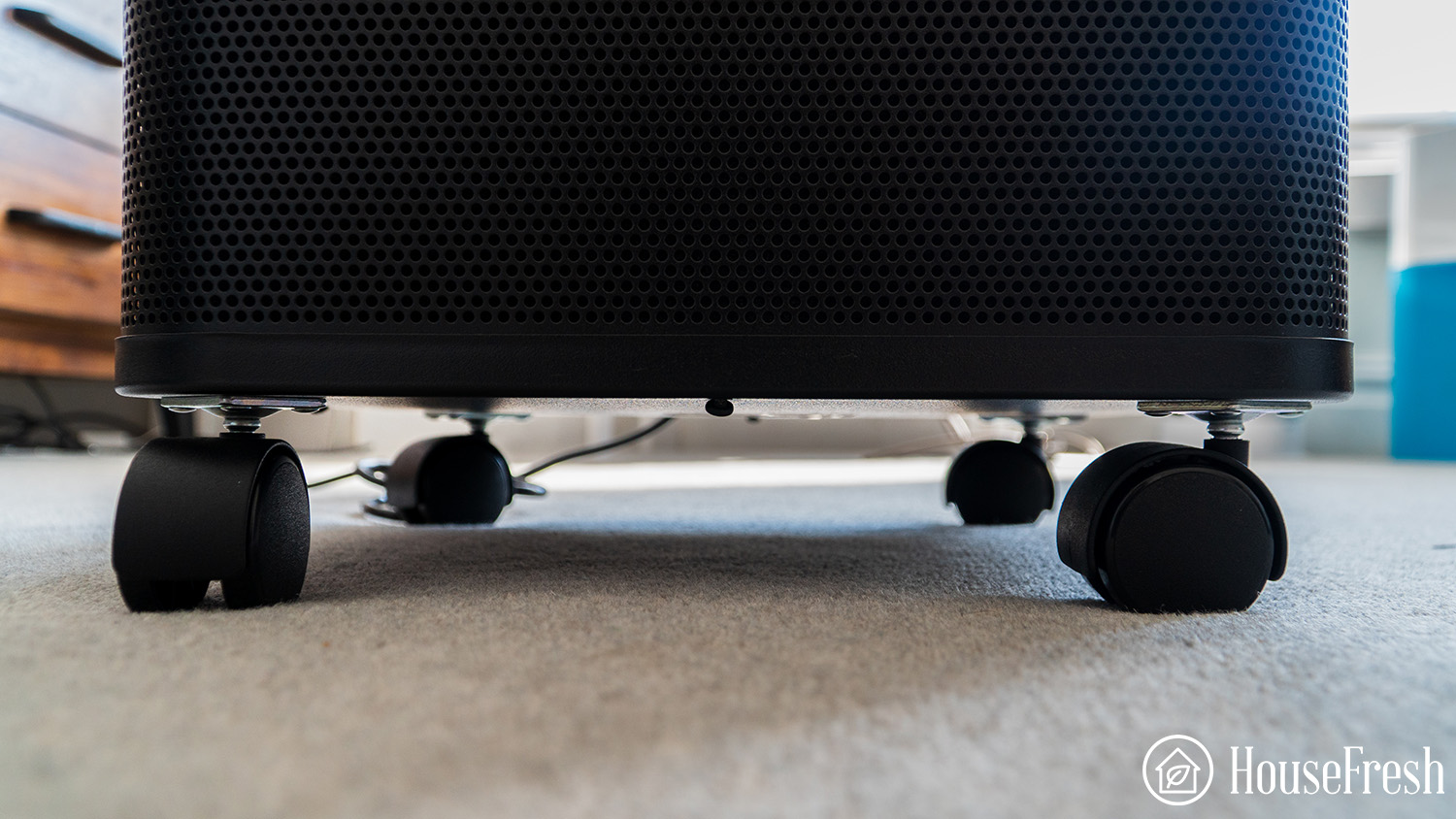
I liked the black color, but you can also choose sandstone if you prefer that color scheme.
The Austin Air team didn’t reinvent the wheel with its control system. The HealthMate has a simple 3-function switch for switching the unit on and for changing the fan speed.

Considering that VOCs and gasses are tricky to detect with current sensor technology, I understand why they don’t use an auto-mode.
When it comes to its size, we’re talking about an air purifier that will need its fair share of space. However, when compared side-by-side with its biggest competitor (the IQAir HealthPro Plus), you can see that even though the HealthMate has a similar floor footprint but is a much shorter unit.
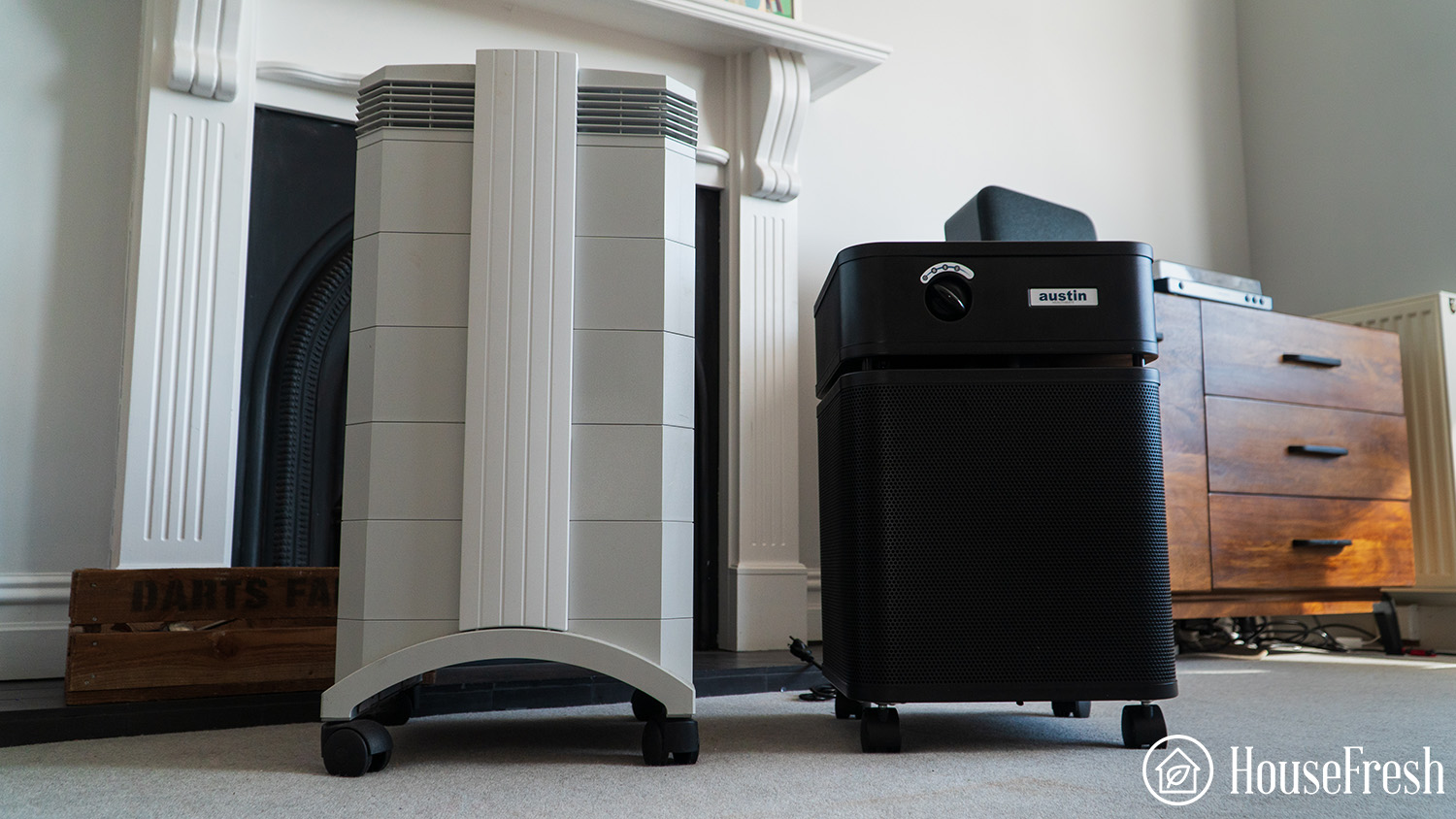
The HealthMate is one of the largest air purifiers we tested, based on weight and dimensions.

But at 45 pounds HealthMate NEEDS the four caster type wheels to get around, and may prove difficult for the elderly or infirm to move about the home, or upstairs.”
This is something to keep in mind, as I know it might look small compared to the IQAir HealthPro Plus but in reality it is a large and incredibly heavy device, due to the heavy filter (packed with charcoal) and a body made completely out of metal (compared to the usual plastic you find in most retail air purifiers).
True HEPA filter and 15 lbs of carbon + zeolite
The Austin Air HealthMate currently has the largest carbon filter in the United States.
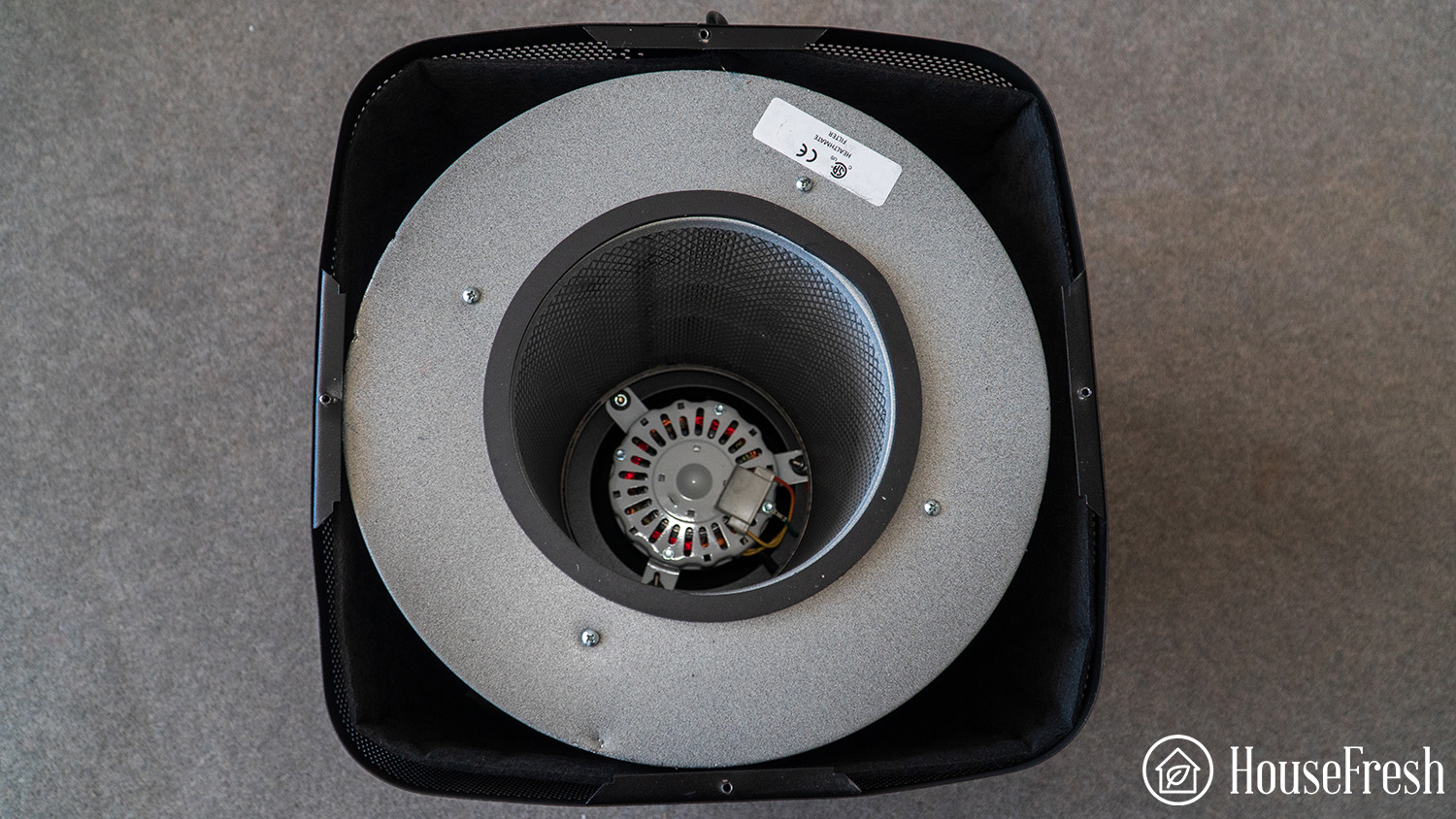
Most air purifiers use a HEPA-based filter with a small amount of activated carbon via impregnated fabric or small pellets. The reason that small amounts of carbon are used is down to price and can quickly increase costs for the initial unit and replacement filters.
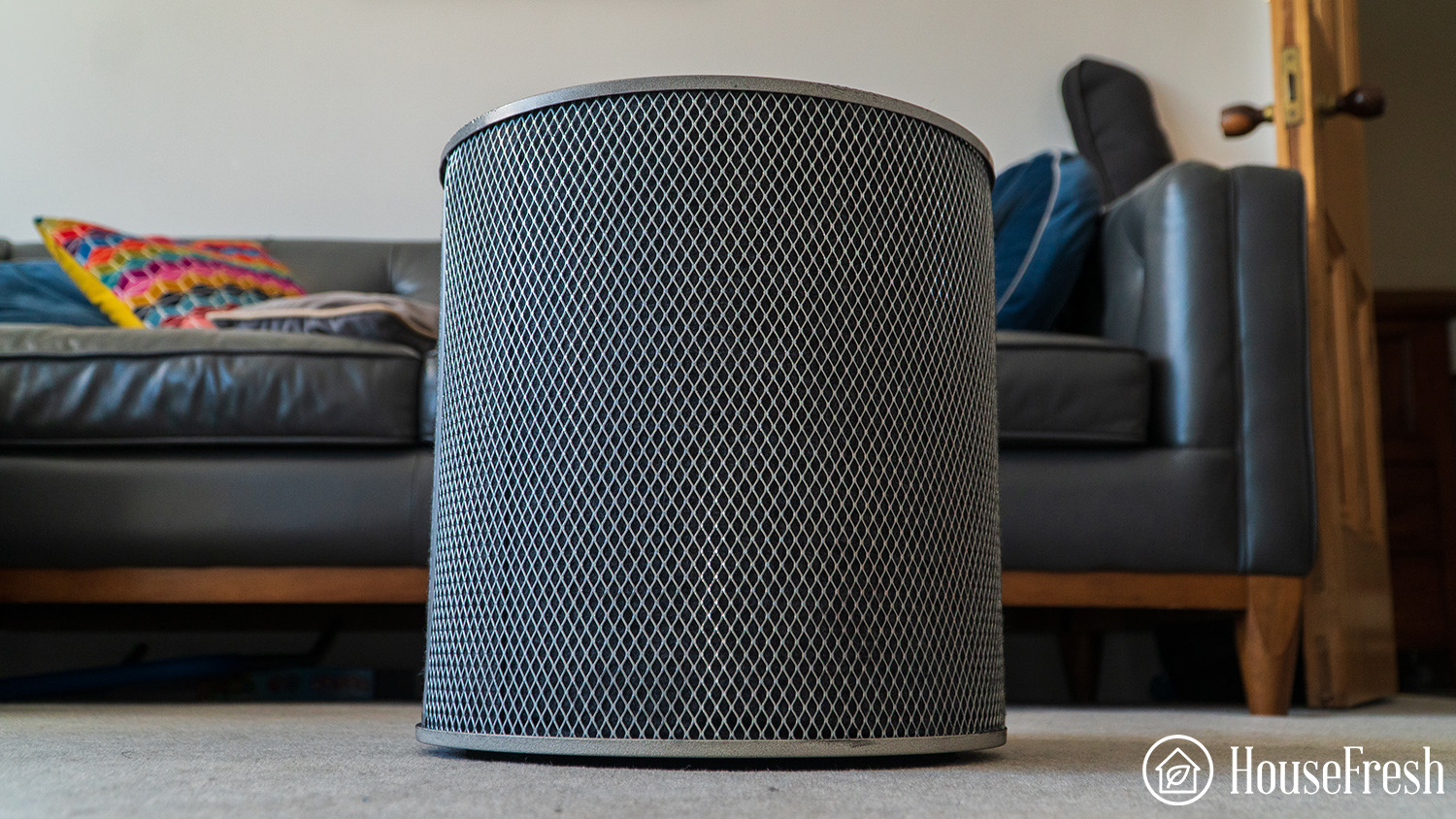
As most indoor air quality issues involve particle pollution, the vast majority of people won’t need a lot of carbon in their air cleaners to deal with the job at hand. However, in cases where you are dealing with unwanted smells, gasses and VOCs, you will want to have the biggest amount of activated carbon available.
Those are the cases where the Austin Air HealthMate can make a real difference.
The filter inside the HealthMate comes with five pounds of activated carbon and zeolite. If you’ve never heard of zeolite, you should know that it helps improve how well the filter can remove VOCs and works similarly to activated carbon, adsorbing and trapping the gasses.
You can see just how big the filter in the Austin Air HealthMate (left) is when comparing it side-by-side with the Levoit Core 300 (right) – this thing is HUGE!

New air purifiers usually come with their filters wrapped in a plastic bag, and this was the case with the Austin Air HealthMate — so I was sure to remove this bag before switching the unit on.
It is worth mentioning that in the case of the HealthMate, replacing the filter is not as straightforward as other units. You will need a screwdriver:
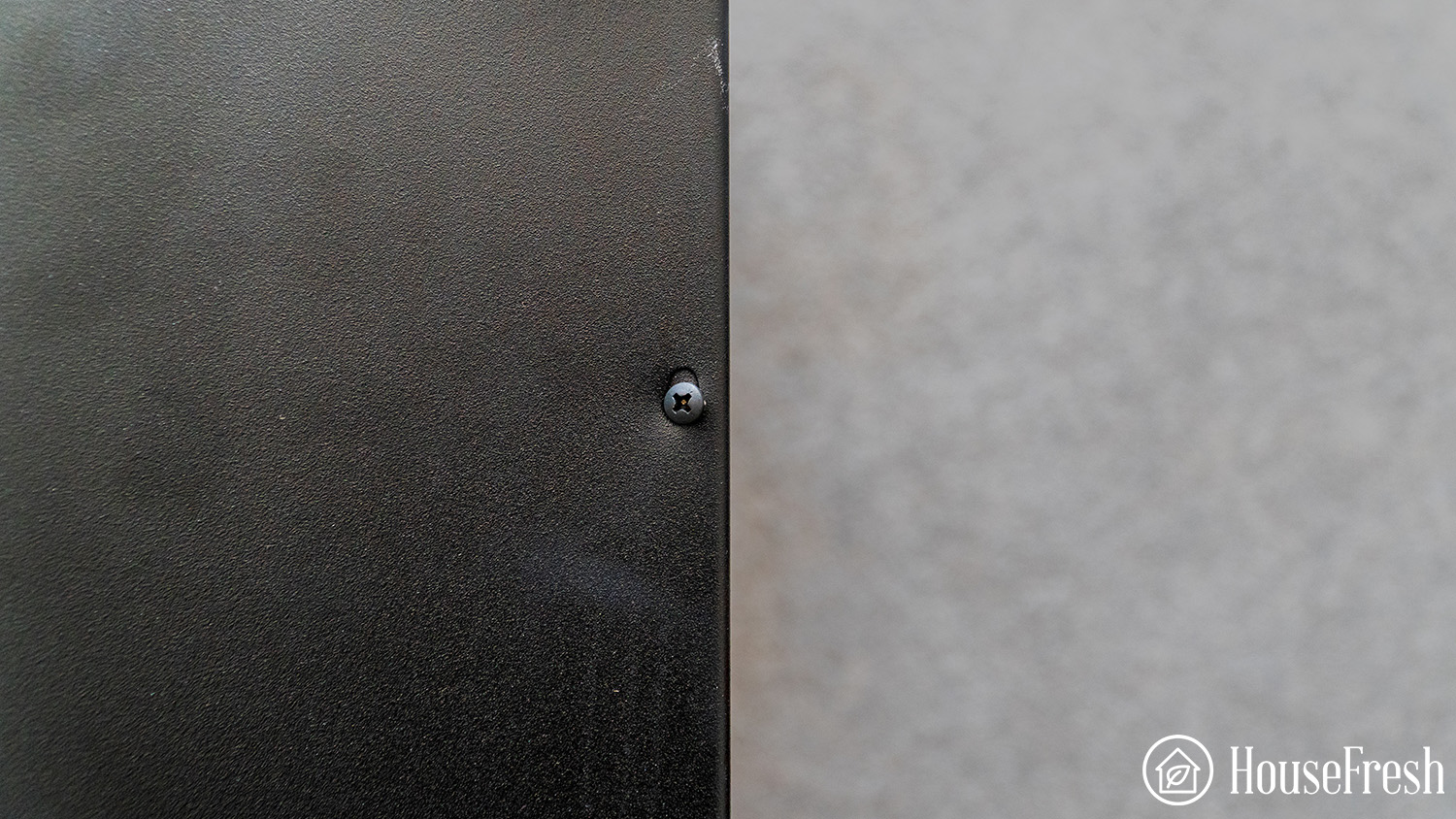
Once you have detached the top of the unit from its body, you will be able to access the filter. Here is how it looks inside:
The Austin Air HealthMate cleared our test room in 52 minutes
This is 24 minutes slower than its biggest competitor: the IQAir HealthPro Plus (28 minutes).
We test all the air purifiers we review here at HouseFresh in the same room of 728 cubic ft so that we can compare their performance side-by-side. We use burning incense to simulate particle pollution and track the levels of PM1.0ug/m3, PM2.5ug/m3 and PM10.0 ug/m3 pollution while the air purifier is running at its top speed.
The result? A timeline that shows us how long it takes for the air purifier to bring PM1 levels down to zero.
Testing air cleaning performance at top speed
In the case of the Austin Air HealthMate, we recorded 52 minutes from the moment we turned the device on a top speed and the moment that PM1 levels in the air reached zero. You can see the test data in the chart below:
But this information in isolation probably doesn’t mean much to you, so I made a table to show you how the performance of the Austin Air HealthMate compares to other devices we have tested:
| AIR PURIFIER MODEL | TIME TO REACH PM1 ZERO AT FULL SPEED | LIST PRICE |
|---|---|---|
| Smart Air Blast Mini MKII | 15 minutes | $649.00 |
| Levoit EverestAir | 16 minutes | $499.99 |
| Alen BreatheSmart 45i | 30 minutes | $429.00 |
| Winix 5500-2 | 23 minutes | $249.99 |
| Rabbit Air A3 | 24 minutes | $749.95 |
| Coway Airmega AP-1512hh Mighty | 26 minutes | $229.99 |
| IQAir HealthPro Plus | 28 minutes | $1000.00 |
| AirDoctor 3000 | 30 minutes | $519.00 |
| Austin Air HealthMate | 52 minutes | $756.00 |
If this air purifier were to have been designed with the focus of removing particles from the air, then the results could be seen as unimpressive, considering that it cleaned our test room at a similar rate to the Levoit Core 300 (54 minutes), which is available for $99.
But you must consider that the Austin Air is designed to remove gasses and VOCs due to its larger-than-normal activated carbon and zeolite filter. And the thing with large amounts of carbon is that they restrict airflow, so this will have an effect in the particle removal performance of this air purifier.
Luckily our upgraded Purple Air Indoor sensor has the latest BME68 sensor that allows us to also track the level of VOCs in the air.
Removing gasses takes much longer and even with the large filter of the Austin Air HealthMate, you can see that VOC levels are drastically reduced over the next few hours after we perform our particle test. By 2 p.m., we had reduced the level of VOC from 433.65ppm to 50.52ppm.
Testing air cleaning performance at sub-45 dB
We have received a lot of feedback from readers who wanted to know what was the air cleaning performance of the Austin Air HealthMate when running at lower fan speeds. That is why we repeated the particle removal test above but using a fan speed where the HealthMate generates less than 45 dBA, which is the limit recommended by CleanAirStars for noisy classrooms or offices.
The only speed that is quieter than 45 dBA is speed 1 (42 dBA). When we tested the HealthMate clearing incense smoke from our 728 cubic feet test room at speed 1, it needed 76 minutes to reach PM1 zero.
Using our CADR calculator we estimated a CADR of 76 cfm, which would be good to offer 4.8 air changes per hour in a space of up to 120 sq. ft.
Noise levels test results
We used a sound monitor to record (from 3 feet away) how much noise is generated by the HealthMate when running at each of its fan speeds:
| Speed | Sound Level |
| 1 | 42.0 dB |
| 2 | 53.2 dB |
| 3 | 61.5 dB |
At the lowest fan speed, the Austin Air HealthMate hits a comfortable 42 dB, but it maxes out at 61.5 dB when running at its top fan speed. This is how this compares to other devices we tested:
| AIR PURIFIER MODEL | SOUND LEVEL AT TOP SPEED (dB) | TIME TO CLEAN OUR TEST ROOM |
|---|---|---|
| Smart Air Blast Mini MKII | 56.3 dB | 15 minutes |
| Levoit EverestAir | 57.8 dB | 16 minutes |
| Coway Airmega AP-1512hh Mighty | 60.1 dB | 25 minutes |
| IQAir Healthpro Plus | 61.2 dB | 28 minutes |
| Austin Air HealthMate HM400 | 61.5 dB | 52 minutes |
| AirDoctor 3000 | 63.6 dB | 20 minutes |
The ability to remove VOCs will likely require a more substantial fan to push the air through the large filter, so more noise is expected. While it’s not painfully loud, it would be too loud if you had to work in the same room.
That being said, I know that noise is subjective. Have a listen for yourself so you can assess whether the Austin Air HealthMate is too noisy for you.
The cost to run an Austin Air HealthMate: $283.03 per year
As with all the air purifier reviews we publish here at HouseFresh, we did the math to calculate how much you should budget to run this specific device for a year accounting for energy costs and filter replacement costs.
1. Electricity costs = $164.39 per year
Before calculating energy costs, we used a power meter to measure just how much electricity the HealthMate consumes at each of its fan speeds:
| Fan speed | Energy consumed |
| 1 | 61.1 watts |
| 2 | 85.05 watts |
| 3 | 147.6 watts |
You can see in the table below how this compares to other air purifiers we tested:
| AIR PURIFIER MODEL | ENERGY CONSUMPTION AT TOP SPEED (watts) | TIME TO CLEAN OUR TEST ROOM |
|---|---|---|
| Winix 5500-2 | 53.8 Watts | 23 minutes |
| Rabbit Air A3 | 59.45 watts | 24 minutes |
| Levoit EverestAir | 69.8 watts | 16 minutes |
| AirDoctor 3000 | 94.2 watts | 20 minutes |
| Smart Air Blast Mini MKII | 122.7 watts | 15 minutes |
| IQAir HealthPro Plus | 145.5 watts | 28 minutes |
| Austin Air HealthMate HM400 | 147.6 watts | 52 minutes |
With this data in hand, I then used the appliance energy consumption calculator from the U.S. Department of Energy to estimate how much you would pay in electricity bills to run this air purifier all day, every day.
So, if you had the Austin Air HealthMate running in the background 24/7 at top speed, this would add $164.39 to your yearly energy bill.
2. Filter costs = $57.90 per year
The replacement filters for the HealthMate costs a whopping price of $289.99. Still, luckily, you only need to replace the filter every five years, which is way more in line with the costs of other air purifiers on the market.
Considering the large amounts of activated carbon, the filter costs seem very fair, but it’s still going to be a bit of a shock when you first replace it after five years.
Several generic filters are a little less to purchase, which brings the total cost of filter replacements down to $149, equaling $30 per year in filter costs. Still, based on reviews, I was wary of the quality and recommend sticking with Austin Air genuine filters.
Check the table below to compare the yearly running costs of an Austin Air HealthMate with what you can expect to pay with other similarly-priced and popular air purifiers:
| AIR PURIFIER MODEL | ESTIMATED ELECTRICITY COST (per year) | FILTER REPLACEMENT COST (per year) | YEARLY MAINTENANCE COST |
|---|---|---|---|
| Coway Airmega AP-1512hh Mighty | $83.64 | $39.99 | $123.63 |
| Winix 5500-2 | $57.82 | $79.99 | $137.81 |
| Levoit EverestAir | $73.58 | $99.99 | $173.57 |
| Smart Air SA600 | $56.55 | $141.47 | $198.02 |
| AirDoctor 3000 | $104.63 | $178.00 | $282.63 |
| Austin Air HealthMate | $164.39 | $57.90 | $283.03 |
| Smart Air Blast Mini MKII | $136.29 | $236.99 | $373.28 |
| IQAir HealthPro Plus | $221.47 | $200.00 | $421.47 |
Bottom line
If you don’t have any issues with VOCs or gasses, choose a cheaper air purifier from Winix, Coway or Levoit.
If you have health concerns that tie back to VOCs or are experiencing significant issues with gasses, you can’t get much better than the Austin Air HealthMate and its 15 lbs of activated carbon and zeolite.
However, for the vast majority of use cases, spending $700+ on this device will be overkill and unnecessary.
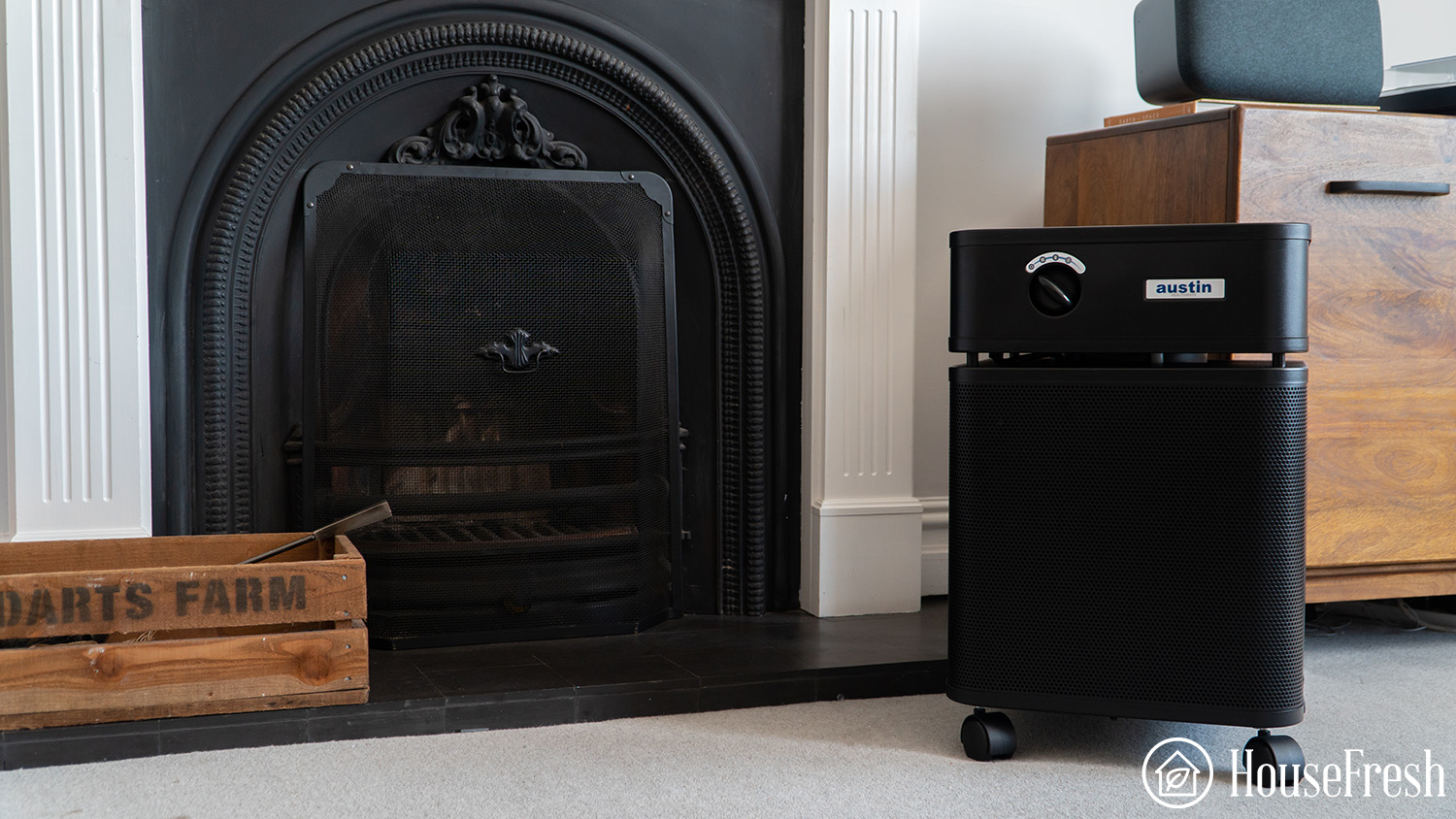
The HealthMate comes with much more activated carbon than the IQAir HealthPro Plus (5 lbs VS 15 lbs) and is cheaper to buy and run. But when it comes to particle removal performance, the HealthPro Plus will offer you better bang for your buck – even at its higher price.
So for those looking for the best air purifier for dealing with serious VOCs, then the Austin Air HealthMate is definitely a top contender. But if you are just looking for a good air purifier that will help with common kitchen odors, dust and pollen, then you will be able to find a device for a fraction of the price in our list of the best air purifiers we recommend right now.
And if you’re looking at the HealthMate because you’re looking for an air purifier made in the USA, then you should also check out the Luggable XL-7 from the team at CleanAirKits. It doesn’t come with activated carbon so it will be useless against odors and gases but its particle removal performance is INCREDIBLE, it is whisper quiet thanks to the use of PC fans AND all the DIY kits are made in the USA.
SOURCES
We calculated yearly costs associated with running the Austin Air Health Mate 24 hours a day, 365 days per year utilizing the appliance electricity consumption calculator from the U.S. Department of Energy as of January 2025.



